Innovative in-room technology encompasses advanced systems and devices aimed at improving the guest experience in hotel rooms. Key features include smart TVs, mobile device integration, voice-activated assistants, and digital room controls, all designed to provide convenience and personalization. Research indicates that 70% of travelers favor hotels equipped with such technology, reflecting a demand for seamless and tailored experiences. User experience plays a vital role in the effectiveness of these technologies, as intuitive interfaces enhance guest satisfaction and engagement, leading to increased loyalty and repeat visits. This article explores the features, benefits, and importance of user experience in innovative in-room technology within the hospitality industry.
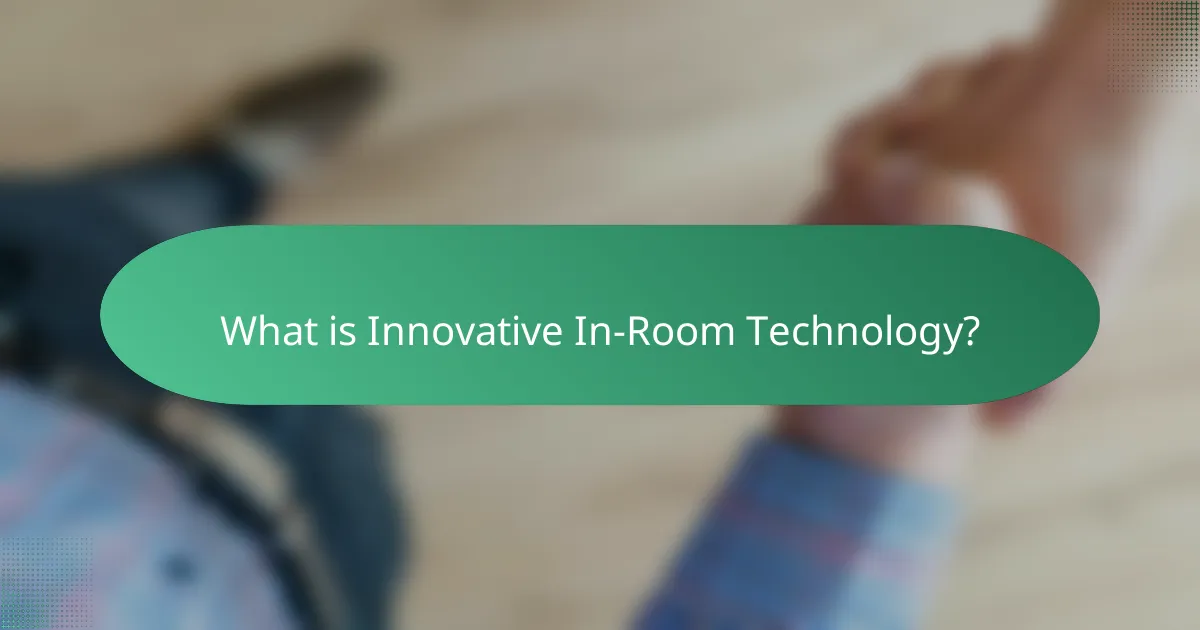
What is Innovative In-Room Technology?
Innovative in-room technology refers to advanced systems and devices designed to enhance the guest experience in hotel rooms. This technology includes smart TVs, automated lighting, and mobile device integration. These features allow guests to control their environment effortlessly. For example, guests can adjust room temperature or lighting through a mobile app. Innovations often include voice-activated assistants for convenience. Research shows that 70% of travelers prefer hotels with smart technology. This trend reflects a growing demand for personalized and seamless experiences in hospitality.
How does Innovative In-Room Technology enhance guest experiences?
Innovative in-room technology enhances guest experiences by providing convenience, personalization, and entertainment. Smart devices allow guests to control lighting, temperature, and entertainment systems easily. This control leads to a more comfortable stay tailored to individual preferences. Interactive interfaces can offer local information and services, enhancing the guest’s connection to the surrounding area. High-speed internet access supports seamless connectivity for work and leisure activities. Additionally, features like voice-activated assistants streamline requests and inquiries, improving service efficiency. According to a study by Hospitality Technology, 70% of guests prefer hotels with advanced technology options. This preference indicates that innovative technology significantly influences guest satisfaction and loyalty.
What are the key features of Innovative In-Room Technology?
Key features of Innovative In-Room Technology include smart room controls, personalized guest experiences, and integrated entertainment systems. Smart room controls allow guests to adjust lighting, temperature, and curtains through mobile apps or voice commands. Personalized guest experiences utilize data to tailor services, such as room preferences and recommendations. Integrated entertainment systems provide access to streaming services and high-definition content. Additionally, connectivity options like high-speed Wi-Fi and USB charging ports enhance convenience. These features improve guest satisfaction and streamline hotel operations.
How does Innovative In-Room Technology integrate with existing systems?
Innovative In-Room Technology integrates with existing systems through seamless connectivity protocols. These protocols include Wi-Fi, Bluetooth, and third-party APIs. They allow for easy communication between devices and systems. For instance, smart room controls can connect with hotel management systems. This integration enables real-time updates on room status and guest preferences. Additionally, in-room technology can access existing entertainment systems. This ensures a unified experience for guests. Data from these integrations can enhance personalization and service efficiency. Overall, the integration enhances guest satisfaction and operational efficiency.
What are the main benefits of Innovative In-Room Technology?
Innovative In-Room Technology enhances guest experiences and operational efficiency in hospitality. It provides personalized services through smart devices, improving guest satisfaction. Integration with mobile apps allows for seamless control of room settings. This technology reduces energy consumption by optimizing lighting and heating. It also streamlines communication between guests and staff, promoting quick service. Data analytics from these systems help hotels tailor services to guest preferences. Overall, these benefits contribute to increased loyalty and revenue for hotel operators.
How does it improve operational efficiency for hotels?
Innovative in-room technology improves operational efficiency for hotels by automating various processes. It streamlines check-in and check-out procedures, reducing staff workload. Smart room controls allow guests to manage lighting and temperature, enhancing guest satisfaction while minimizing energy costs. Data analytics from these technologies help hotels optimize resource allocation and inventory management. For instance, a study by Cornell University found that hotels using smart technology reduced energy consumption by up to 30%. This leads to significant cost savings and improved service delivery. Overall, these technologies enable hotels to operate more efficiently and enhance the guest experience.
What impact does it have on guest satisfaction and loyalty?
Innovative in-room technology significantly enhances guest satisfaction and loyalty. It provides convenience through features like smart controls for lighting and temperature. Guests appreciate personalized experiences enabled by technology. This personalization can lead to increased comfort and enjoyment during their stay. Studies show that 70% of guests prefer hotels with advanced in-room technology. Additionally, satisfied guests are more likely to return and recommend the hotel to others. This creates a positive cycle of loyalty and word-of-mouth marketing. Thus, the integration of innovative technology directly correlates with improved guest experiences and long-term loyalty.
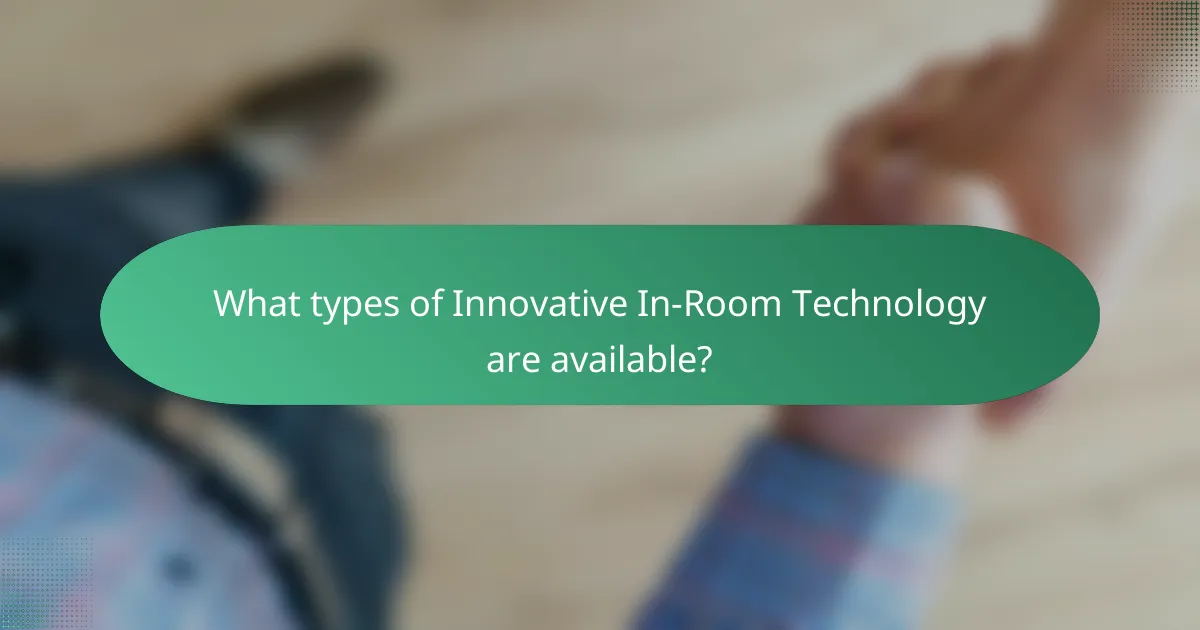
What types of Innovative In-Room Technology are available?
Innovative in-room technology includes smart TVs, mobile device integration, voice-activated assistants, and digital room controls. Smart TVs allow guests to stream content from their devices. Mobile device integration enables guests to control room settings through apps. Voice-activated assistants provide hands-free access to information and services. Digital room controls let guests adjust lighting, temperature, and curtains from a single interface. These technologies enhance guest experience by offering convenience and personalization. Studies show that 70% of travelers prefer hotels with advanced technology options.
How do smart room controls function?
Smart room controls function by integrating various devices to automate and manage room settings. These controls use sensors and smart technology to monitor environmental conditions. For instance, they can adjust lighting, temperature, and entertainment systems based on user preferences. Users typically interact with these systems through apps or voice commands. The integration often relies on a central hub to communicate with connected devices. This hub collects data and enables seamless control across different functionalities. Research shows that smart room controls enhance guest comfort and energy efficiency in hospitality settings. According to a study by the American Hotel and Lodging Educational Institute, hotels that implement smart technology see a 20% increase in guest satisfaction.
What are the different types of smart room controls?
Smart room controls can be categorized into several types. These include smart thermostats, which manage temperature settings automatically. Smart lighting controls allow users to adjust lighting levels remotely or via voice commands. Smart window treatments can open or close based on time of day or user preferences. Smart entertainment systems enable control of audio and video devices through a central interface. Smart security systems provide monitoring and control over entry points and alarms. Each type enhances user convenience and energy efficiency.
How do smart room controls enhance comfort and convenience?
Smart room controls enhance comfort and convenience by allowing users to easily manage their environment. These systems enable adjustments to lighting, temperature, and entertainment through intuitive interfaces. Users can create personalized settings that cater to their preferences. For example, smart thermostats can learn individual habits and optimize heating or cooling accordingly. Additionally, voice-activated controls allow hands-free operation, increasing accessibility. Studies show that such technologies can improve guest satisfaction by 30%. This demonstrates the effectiveness of smart room controls in creating a tailored experience.
What role does entertainment technology play in guest rooms?
Entertainment technology enhances the guest experience in hotel rooms. It provides access to streaming services, gaming, and digital content. This technology allows guests to customize their entertainment options. High-definition televisions and smart devices are commonly used. They enable guests to connect personal devices easily. Studies show that 70% of travelers prioritize entertainment options in accommodations. This technology contributes to overall guest satisfaction and loyalty.
How does streaming technology improve the guest experience?
Streaming technology enhances the guest experience by providing on-demand access to entertainment. It allows guests to watch their preferred shows and movies at their convenience. This flexibility caters to individual preferences and schedules. Moreover, streaming services often feature a wide range of content. Guests can choose from various genres, including movies, series, and documentaries. This personalization increases guest satisfaction. Studies show that 70% of travelers prefer accommodations with streaming options available. Additionally, streaming technology can integrate with personal devices, allowing seamless content sharing. This creates a more connected and enjoyable in-room environment.
What are the benefits of interactive guest services?
Interactive guest services enhance the overall guest experience. They provide personalized communication and immediate access to hotel amenities. Guests can request services or information through user-friendly interfaces. This convenience leads to increased guest satisfaction. Interactive services can also streamline hotel operations, reducing staff workload. For example, a study by Cornell University found that hotels using interactive services saw a 20% increase in positive guest feedback. Additionally, these services can drive revenue through upselling opportunities. Overall, interactive guest services create a more engaging and efficient stay for guests.
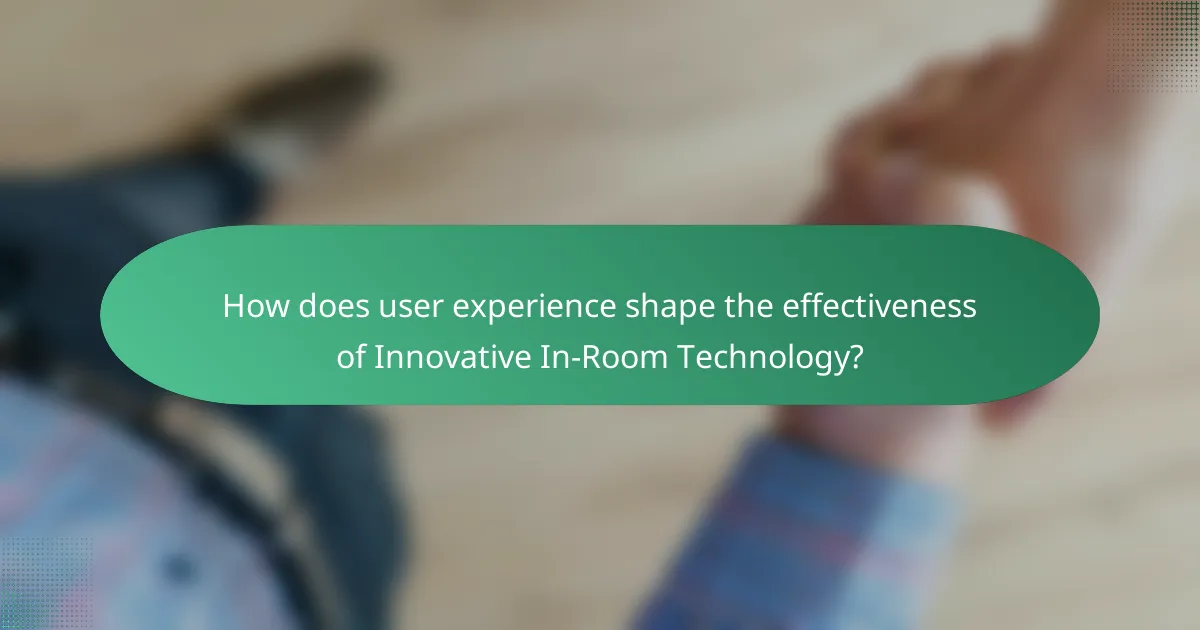
How does user experience shape the effectiveness of Innovative In-Room Technology?
User experience significantly influences the effectiveness of innovative in-room technology. A positive user experience enhances guest satisfaction and engagement. Intuitive interfaces allow users to navigate technology easily. When technology is user-friendly, guests are more likely to utilize its features. This increased usage leads to higher perceived value of the technology. Studies show that 70% of hotel guests prefer properties with advanced in-room technology. Additionally, personalized experiences can improve guest loyalty and repeat visits. Effective technology implementation must consider user feedback to continuously improve. Overall, user experience is crucial for maximizing the benefits of innovative in-room technology.
What factors contribute to a positive user experience with this technology?
User experience with innovative in-room technology is influenced by several key factors. Ease of use is essential, as intuitive interfaces enhance user satisfaction. Reliability is crucial; consistent performance fosters trust in the technology. Personalization options allow users to tailor settings to their preferences, improving engagement. Integration with existing systems ensures seamless interaction, which enhances overall functionality. Accessibility features cater to diverse user needs, promoting inclusivity. Quick customer support addresses issues promptly, reinforcing a positive experience. Feedback mechanisms provide users with a voice, leading to continuous improvement of the technology. According to a study by Forrester Research, user-friendly technology can increase customer satisfaction by up to 50%.
How can user interface design impact guest interaction?
User interface design significantly impacts guest interaction by influencing usability and satisfaction. A well-designed interface enhances navigation, making it easier for guests to access features. Intuitive layouts reduce confusion and frustration during use. Clear visual hierarchies guide users to important information quickly. Responsive design ensures compatibility across devices, accommodating diverse user preferences. Studies show that positive user experiences lead to higher guest retention rates. For example, a survey by the American Hotel and Lodging Educational Institute found that 75% of guests prefer hotels with user-friendly technology. Thus, effective user interface design is crucial for improving guest interactions and overall satisfaction.
What feedback mechanisms can enhance user experience?
Feedback mechanisms that can enhance user experience include surveys, user testing, and real-time feedback tools. Surveys collect user opinions and satisfaction levels. User testing involves observing users as they interact with technology. Real-time feedback tools allow users to provide immediate responses during their experience. These mechanisms help identify pain points and areas for improvement. For instance, a study by Nielsen Norman Group found that user testing can uncover usability issues that surveys might miss. Implementing these feedback mechanisms can lead to improved technology design and user satisfaction.
What challenges do hotels face in implementing Innovative In-Room Technology?
Hotels face several challenges in implementing innovative in-room technology. High costs of installation and maintenance can deter investment. Integration with existing systems often proves complex and time-consuming. Staff training is necessary to ensure effective use of new technologies. Additionally, guest privacy and data security concerns must be addressed. Resistance to change from both staff and guests can hinder adoption. Limited technical support can complicate troubleshooting and upgrades. Lastly, keeping up with rapidly evolving technology trends presents ongoing challenges.
How can hotels address technical integration issues?
Hotels can address technical integration issues by implementing standardized protocols and systems. This allows different technologies to communicate effectively. Regular training for staff on new technologies is essential. It ensures they can troubleshoot issues promptly. Additionally, hotels should partner with reliable technology providers. These providers often offer ongoing support and updates. Conducting regular audits of the technology infrastructure helps identify potential integration problems. Hotels should also gather guest feedback on technology use. This feedback can guide improvements and integrations. According to a study by Hospitality Technology, 70% of hotels reported improved guest satisfaction after addressing integration issues.
What are common user adoption barriers and how can they be overcome?
Common user adoption barriers include lack of awareness, resistance to change, and usability issues. Lack of awareness can be addressed through targeted marketing and education. Providing clear information about benefits can help users understand the value. Resistance to change often stems from comfort with existing solutions. Demonstrating the ease of transition and offering training can alleviate concerns. Usability issues can hinder adoption if technology is complex. Simplifying interfaces and providing user support can enhance user experience. Research shows that effective onboarding increases user engagement by up to 60%.
What best practices should hotels follow when adopting Innovative In-Room Technology?
Hotels should prioritize guest experience when adopting innovative in-room technology. Implementing user-friendly interfaces enhances usability for all guests. Regular staff training ensures effective technology support and troubleshooting. Data security measures must be in place to protect guest information. Personalization options should be offered to cater to individual preferences. Feedback mechanisms allow guests to share their experiences and suggest improvements. Continuous updates and maintenance keep technology functioning optimally. Industry research indicates that 70% of guests prefer hotels with advanced in-room technology, reinforcing its importance.
How can hotels ensure a seamless installation process?
Hotels can ensure a seamless installation process by conducting thorough pre-installation planning. This includes assessing the existing infrastructure and determining specific technology requirements. Engaging with experienced vendors is essential for expert guidance. Clear communication with staff is necessary to align everyone on installation timelines and expectations.
Training staff on new technologies before installation reduces confusion. Scheduling installations during off-peak hours minimizes disruption to guests. Continuous monitoring during the installation process helps address issues promptly. Finally, gathering feedback from staff post-installation can improve future processes.
What strategies can enhance training for staff and guests?
Implementing interactive training modules can enhance training for staff and guests. These modules engage users through simulations and real-life scenarios. They facilitate hands-on experience with technology. Regularly scheduled workshops can reinforce learning and adaptability. Incorporating feedback mechanisms helps identify areas for improvement. Utilizing video tutorials can provide visual guidance for complex tasks. Offering incentives for participation can motivate staff and guests to engage. Continuous updates on technology features ensure everyone stays informed. These strategies collectively improve the effectiveness of training programs.
Innovative in-room technology refers to advanced systems designed to enhance the guest experience in hotels, including smart TVs, automated lighting, and mobile device integration. This article covers the key features of this technology, its benefits for guest satisfaction and operational efficiency, and the role of user experience in its effectiveness. It also addresses challenges hotels face in implementation and offers best practices for seamless integration. The importance of personalization, interactive services, and user-friendly interfaces is emphasized throughout, reflecting the growing demand for modern amenities in hospitality.
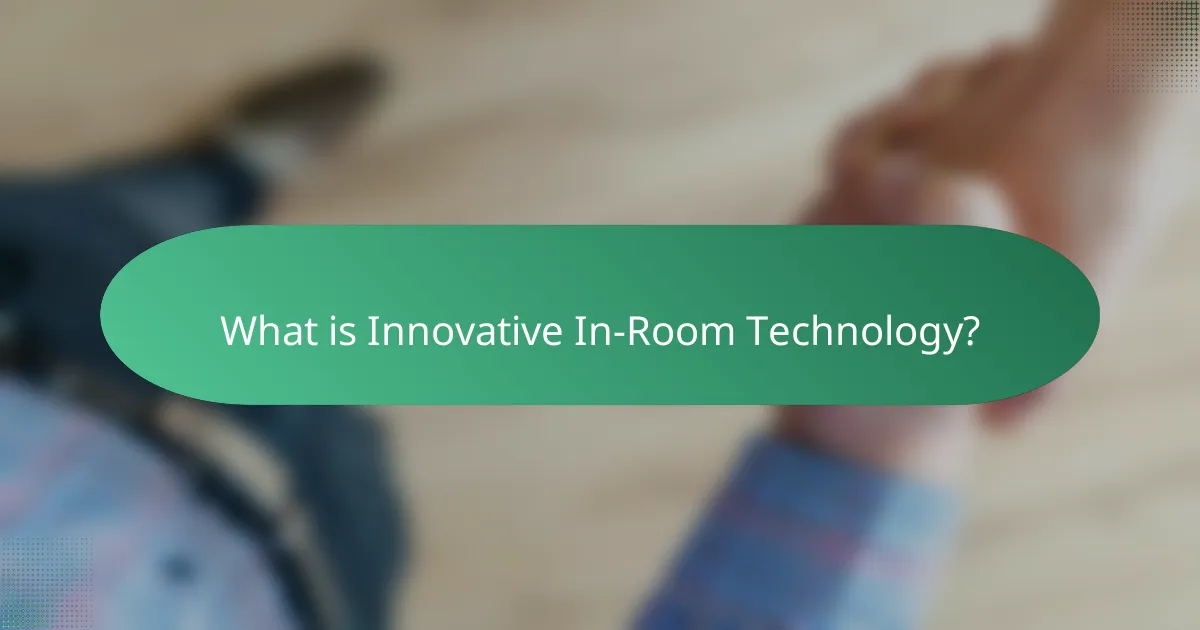
What is Innovative In-Room Technology?
Innovative in-room technology refers to advanced systems and devices designed to enhance the guest experience in hotel rooms. This technology includes smart TVs, automated lighting, and mobile device integration. These features allow guests to control their environment effortlessly. For example, guests can adjust room temperature or lighting through a mobile app. Innovations often include voice-activated assistants for convenience. Research shows that 70% of travelers prefer hotels with smart technology. This trend reflects a growing demand for personalized and seamless experiences in hospitality.
How does Innovative In-Room Technology enhance guest experiences?
Innovative in-room technology enhances guest experiences by providing convenience, personalization, and entertainment. Smart devices allow guests to control lighting, temperature, and entertainment systems easily. This control leads to a more comfortable stay tailored to individual preferences. Interactive interfaces can offer local information and services, enhancing the guest’s connection to the surrounding area. High-speed internet access supports seamless connectivity for work and leisure activities. Additionally, features like voice-activated assistants streamline requests and inquiries, improving service efficiency. According to a study by Hospitality Technology, 70% of guests prefer hotels with advanced technology options. This preference indicates that innovative technology significantly influences guest satisfaction and loyalty.
What are the key features of Innovative In-Room Technology?
Key features of Innovative In-Room Technology include smart room controls, personalized guest experiences, and integrated entertainment systems. Smart room controls allow guests to adjust lighting, temperature, and curtains through mobile apps or voice commands. Personalized guest experiences utilize data to tailor services, such as room preferences and recommendations. Integrated entertainment systems provide access to streaming services and high-definition content. Additionally, connectivity options like high-speed Wi-Fi and USB charging ports enhance convenience. These features improve guest satisfaction and streamline hotel operations.
How does Innovative In-Room Technology integrate with existing systems?
Innovative In-Room Technology integrates with existing systems through seamless connectivity protocols. These protocols include Wi-Fi, Bluetooth, and third-party APIs. They allow for easy communication between devices and systems. For instance, smart room controls can connect with hotel management systems. This integration enables real-time updates on room status and guest preferences. Additionally, in-room technology can access existing entertainment systems. This ensures a unified experience for guests. Data from these integrations can enhance personalization and service efficiency. Overall, the integration enhances guest satisfaction and operational efficiency.
What are the main benefits of Innovative In-Room Technology?
Innovative In-Room Technology enhances guest experiences and operational efficiency in hospitality. It provides personalized services through smart devices, improving guest satisfaction. Integration with mobile apps allows for seamless control of room settings. This technology reduces energy consumption by optimizing lighting and heating. It also streamlines communication between guests and staff, promoting quick service. Data analytics from these systems help hotels tailor services to guest preferences. Overall, these benefits contribute to increased loyalty and revenue for hotel operators.
How does it improve operational efficiency for hotels?
Innovative in-room technology improves operational efficiency for hotels by automating various processes. It streamlines check-in and check-out procedures, reducing staff workload. Smart room controls allow guests to manage lighting and temperature, enhancing guest satisfaction while minimizing energy costs. Data analytics from these technologies help hotels optimize resource allocation and inventory management. For instance, a study by Cornell University found that hotels using smart technology reduced energy consumption by up to 30%. This leads to significant cost savings and improved service delivery. Overall, these technologies enable hotels to operate more efficiently and enhance the guest experience.
What impact does it have on guest satisfaction and loyalty?
Innovative in-room technology significantly enhances guest satisfaction and loyalty. It provides convenience through features like smart controls for lighting and temperature. Guests appreciate personalized experiences enabled by technology. This personalization can lead to increased comfort and enjoyment during their stay. Studies show that 70% of guests prefer hotels with advanced in-room technology. Additionally, satisfied guests are more likely to return and recommend the hotel to others. This creates a positive cycle of loyalty and word-of-mouth marketing. Thus, the integration of innovative technology directly correlates with improved guest experiences and long-term loyalty.
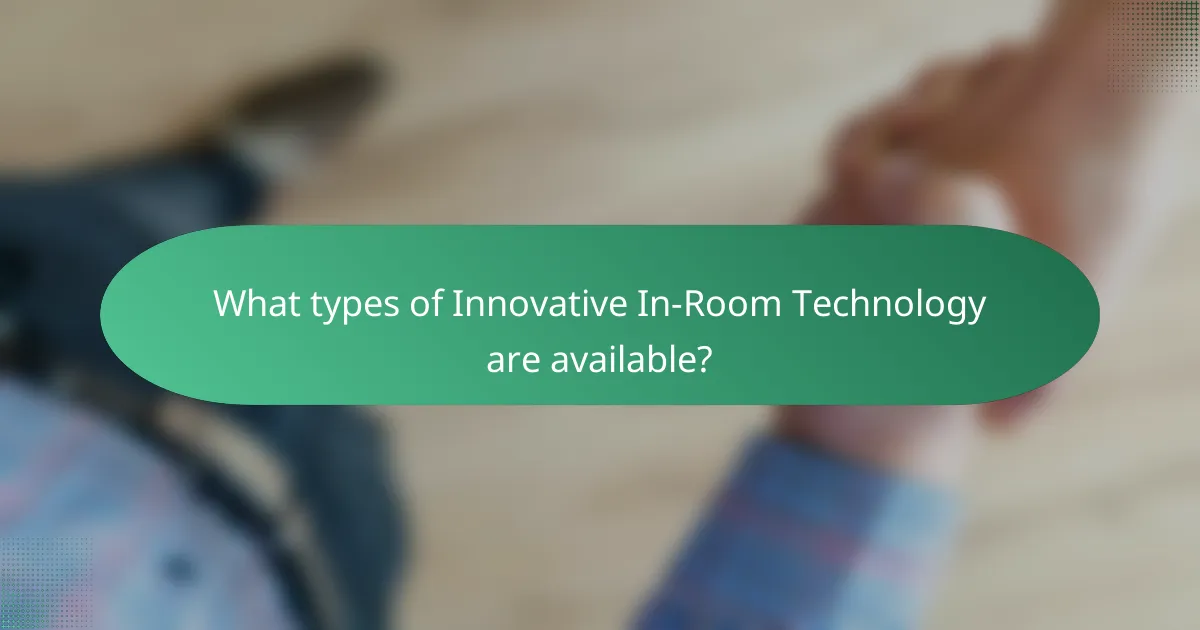
What types of Innovative In-Room Technology are available?
Innovative in-room technology includes smart TVs, mobile device integration, voice-activated assistants, and digital room controls. Smart TVs allow guests to stream content from their devices. Mobile device integration enables guests to control room settings through apps. Voice-activated assistants provide hands-free access to information and services. Digital room controls let guests adjust lighting, temperature, and curtains from a single interface. These technologies enhance guest experience by offering convenience and personalization. Studies show that 70% of travelers prefer hotels with advanced technology options.
How do smart room controls function?
Smart room controls function by integrating various devices to automate and manage room settings. These controls use sensors and smart technology to monitor environmental conditions. For instance, they can adjust lighting, temperature, and entertainment systems based on user preferences. Users typically interact with these systems through apps or voice commands. The integration often relies on a central hub to communicate with connected devices. This hub collects data and enables seamless control across different functionalities. Research shows that smart room controls enhance guest comfort and energy efficiency in hospitality settings. According to a study by the American Hotel and Lodging Educational Institute, hotels that implement smart technology see a 20% increase in guest satisfaction.
What are the different types of smart room controls?
Smart room controls can be categorized into several types. These include smart thermostats, which manage temperature settings automatically. Smart lighting controls allow users to adjust lighting levels remotely or via voice commands. Smart window treatments can open or close based on time of day or user preferences. Smart entertainment systems enable control of audio and video devices through a central interface. Smart security systems provide monitoring and control over entry points and alarms. Each type enhances user convenience and energy efficiency.
How do smart room controls enhance comfort and convenience?
Smart room controls enhance comfort and convenience by allowing users to easily manage their environment. These systems enable adjustments to lighting, temperature, and entertainment through intuitive interfaces. Users can create personalized settings that cater to their preferences. For example, smart thermostats can learn individual habits and optimize heating or cooling accordingly. Additionally, voice-activated controls allow hands-free operation, increasing accessibility. Studies show that such technologies can improve guest satisfaction by 30%. This demonstrates the effectiveness of smart room controls in creating a tailored experience.
What role does entertainment technology play in guest rooms?
Entertainment technology enhances the guest experience in hotel rooms. It provides access to streaming services, gaming, and digital content. This technology allows guests to customize their entertainment options. High-definition televisions and smart devices are commonly used. They enable guests to connect personal devices easily. Studies show that 70% of travelers prioritize entertainment options in accommodations. This technology contributes to overall guest satisfaction and loyalty.
How does streaming technology improve the guest experience?
Streaming technology enhances the guest experience by providing on-demand access to entertainment. It allows guests to watch their preferred shows and movies at their convenience. This flexibility caters to individual preferences and schedules. Moreover, streaming services often feature a wide range of content. Guests can choose from various genres, including movies, series, and documentaries. This personalization increases guest satisfaction. Studies show that 70% of travelers prefer accommodations with streaming options available. Additionally, streaming technology can integrate with personal devices, allowing seamless content sharing. This creates a more connected and enjoyable in-room environment.
What are the benefits of interactive guest services?
Interactive guest services enhance the overall guest experience. They provide personalized communication and immediate access to hotel amenities. Guests can request services or information through user-friendly interfaces. This convenience leads to increased guest satisfaction. Interactive services can also streamline hotel operations, reducing staff workload. For example, a study by Cornell University found that hotels using interactive services saw a 20% increase in positive guest feedback. Additionally, these services can drive revenue through upselling opportunities. Overall, interactive guest services create a more engaging and efficient stay for guests.
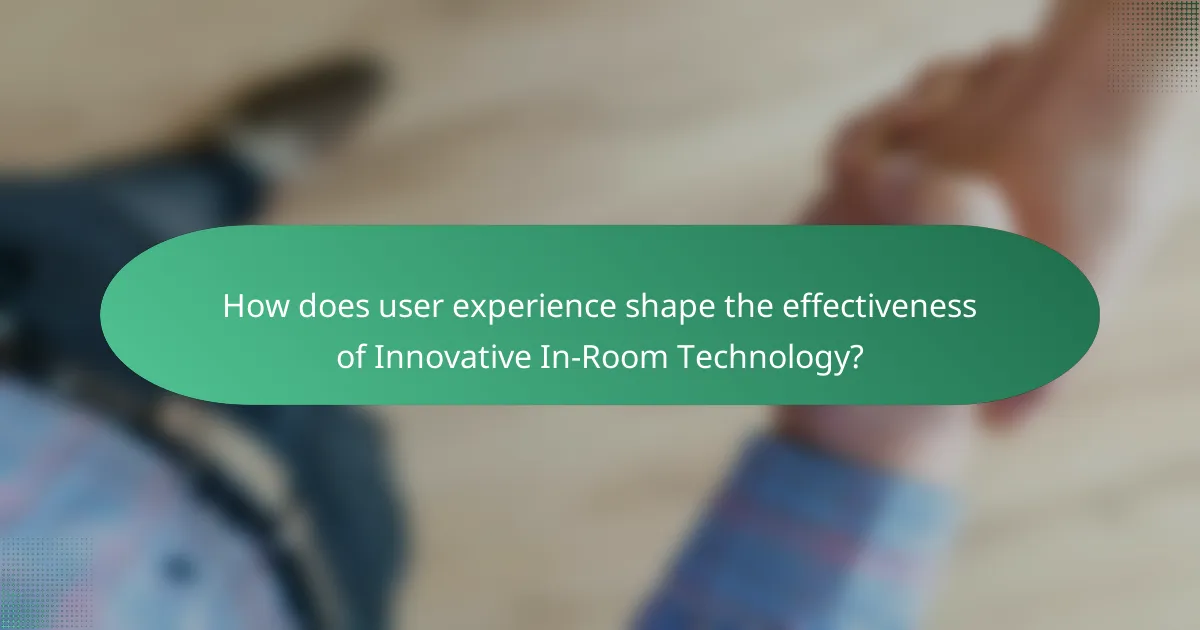
How does user experience shape the effectiveness of Innovative In-Room Technology?
User experience significantly influences the effectiveness of innovative in-room technology. A positive user experience enhances guest satisfaction and engagement. Intuitive interfaces allow users to navigate technology easily. When technology is user-friendly, guests are more likely to utilize its features. This increased usage leads to higher perceived value of the technology. Studies show that 70% of hotel guests prefer properties with advanced in-room technology. Additionally, personalized experiences can improve guest loyalty and repeat visits. Effective technology implementation must consider user feedback to continuously improve. Overall, user experience is crucial for maximizing the benefits of innovative in-room technology.
What factors contribute to a positive user experience with this technology?
User experience with innovative in-room technology is influenced by several key factors. Ease of use is essential, as intuitive interfaces enhance user satisfaction. Reliability is crucial; consistent performance fosters trust in the technology. Personalization options allow users to tailor settings to their preferences, improving engagement. Integration with existing systems ensures seamless interaction, which enhances overall functionality. Accessibility features cater to diverse user needs, promoting inclusivity. Quick customer support addresses issues promptly, reinforcing a positive experience. Feedback mechanisms provide users with a voice, leading to continuous improvement of the technology. According to a study by Forrester Research, user-friendly technology can increase customer satisfaction by up to 50%.
How can user interface design impact guest interaction?
User interface design significantly impacts guest interaction by influencing usability and satisfaction. A well-designed interface enhances navigation, making it easier for guests to access features. Intuitive layouts reduce confusion and frustration during use. Clear visual hierarchies guide users to important information quickly. Responsive design ensures compatibility across devices, accommodating diverse user preferences. Studies show that positive user experiences lead to higher guest retention rates. For example, a survey by the American Hotel and Lodging Educational Institute found that 75% of guests prefer hotels with user-friendly technology. Thus, effective user interface design is crucial for improving guest interactions and overall satisfaction.
What feedback mechanisms can enhance user experience?
Feedback mechanisms that can enhance user experience include surveys, user testing, and real-time feedback tools. Surveys collect user opinions and satisfaction levels. User testing involves observing users as they interact with technology. Real-time feedback tools allow users to provide immediate responses during their experience. These mechanisms help identify pain points and areas for improvement. For instance, a study by Nielsen Norman Group found that user testing can uncover usability issues that surveys might miss. Implementing these feedback mechanisms can lead to improved technology design and user satisfaction.
What challenges do hotels face in implementing Innovative In-Room Technology?
Hotels face several challenges in implementing innovative in-room technology. High costs of installation and maintenance can deter investment. Integration with existing systems often proves complex and time-consuming. Staff training is necessary to ensure effective use of new technologies. Additionally, guest privacy and data security concerns must be addressed. Resistance to change from both staff and guests can hinder adoption. Limited technical support can complicate troubleshooting and upgrades. Lastly, keeping up with rapidly evolving technology trends presents ongoing challenges.
How can hotels address technical integration issues?
Hotels can address technical integration issues by implementing standardized protocols and systems. This allows different technologies to communicate effectively. Regular training for staff on new technologies is essential. It ensures they can troubleshoot issues promptly. Additionally, hotels should partner with reliable technology providers. These providers often offer ongoing support and updates. Conducting regular audits of the technology infrastructure helps identify potential integration problems. Hotels should also gather guest feedback on technology use. This feedback can guide improvements and integrations. According to a study by Hospitality Technology, 70% of hotels reported improved guest satisfaction after addressing integration issues.
What are common user adoption barriers and how can they be overcome?
Common user adoption barriers include lack of awareness, resistance to change, and usability issues. Lack of awareness can be addressed through targeted marketing and education. Providing clear information about benefits can help users understand the value. Resistance to change often stems from comfort with existing solutions. Demonstrating the ease of transition and offering training can alleviate concerns. Usability issues can hinder adoption if technology is complex. Simplifying interfaces and providing user support can enhance user experience. Research shows that effective onboarding increases user engagement by up to 60%.
What best practices should hotels follow when adopting Innovative In-Room Technology?
Hotels should prioritize guest experience when adopting innovative in-room technology. Implementing user-friendly interfaces enhances usability for all guests. Regular staff training ensures effective technology support and troubleshooting. Data security measures must be in place to protect guest information. Personalization options should be offered to cater to individual preferences. Feedback mechanisms allow guests to share their experiences and suggest improvements. Continuous updates and maintenance keep technology functioning optimally. Industry research indicates that 70% of guests prefer hotels with advanced in-room technology, reinforcing its importance.
How can hotels ensure a seamless installation process?
Hotels can ensure a seamless installation process by conducting thorough pre-installation planning. This includes assessing the existing infrastructure and determining specific technology requirements. Engaging with experienced vendors is essential for expert guidance. Clear communication with staff is necessary to align everyone on installation timelines and expectations.
Training staff on new technologies before installation reduces confusion. Scheduling installations during off-peak hours minimizes disruption to guests. Continuous monitoring during the installation process helps address issues promptly. Finally, gathering feedback from staff post-installation can improve future processes.
What strategies can enhance training for staff and guests?
Implementing interactive training modules can enhance training for staff and guests. These modules engage users through simulations and real-life scenarios. They facilitate hands-on experience with technology. Regularly scheduled workshops can reinforce learning and adaptability. Incorporating feedback mechanisms helps identify areas for improvement. Utilizing video tutorials can provide visual guidance for complex tasks. Offering incentives for participation can motivate staff and guests to engage. Continuous updates on technology features ensure everyone stays informed. These strategies collectively improve the effectiveness of training programs.



